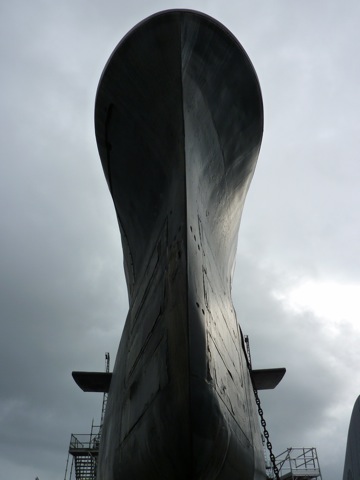
As I’d never been out west before, I allowed myself a couple of days after the Perth conference for sightseeing. First I travelled down to Fremantle, not far south of Perth.
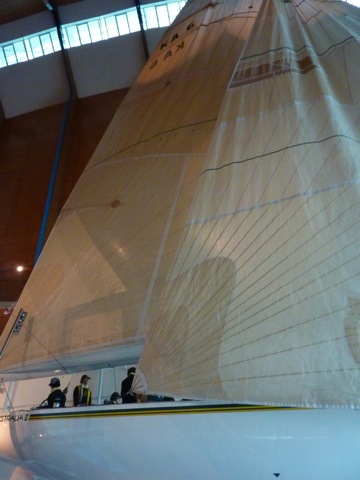
Fremantle is a port city on the Indian Ocean, which is why it has not one but two branches of the Western Australian Museum devoted to maritime history. The biggest and flashest is the Western Australian Museum — Maritime (let’s just call it the Maritime Museum). Among its treasures is perhaps the most iconic ship in Australian history — certainly for someone of my generation.
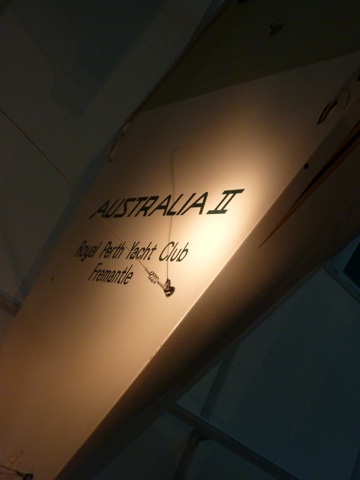
That ship is the racing yacht Australia II, which won the America’s Cup in 1983. It’s probably not too surprising that a sports-mad country like Australia would care more about such a vessel than, say, HMS Endeavour, the Royal Navy ship which ‘discovered’ it (that is to say, it didn’t). And it was an impressive feat: the oldest trophy in international sport (it was first contested in 1851), at the time the America’s Cup had never been won by anyone other than the New York Yacht Club. But I was very far from sports-mad at the time (and very young too, I hasten to add!), and I was carried along with the euphoria like every-one else. It seems hard to explain now.
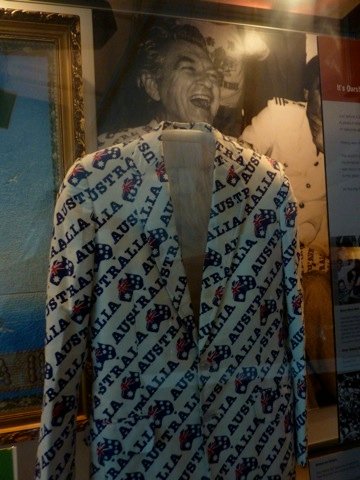
For example, what are we to make of this? It’s the almost-as-iconic, and very much tackier, jacket worn by our then-prime minister, Bob Hawke, as he watched the final race, after which he famously said ‘Any boss who sacks anyone for not turning up today is a bum’. And yet more Australian icons emerged from the 1983 challenge: the ‘Boxing Kangaroo’ flag and Men At Work’s song ‘Down Under’, both used by Australia II‘s crew, and both since adopted more widely to represent Australia to the world, in sport and elsewhere. Clearly there was something going on here to do with Australian identity and our place in the world.
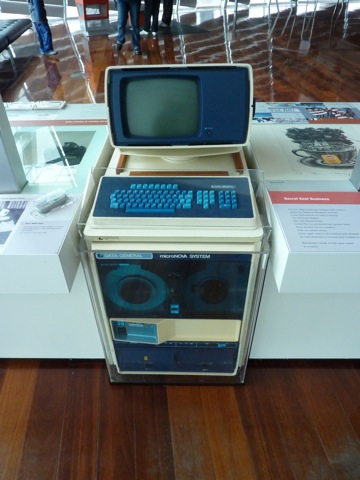
But another aspect to the Australia II‘s campaign which I remember being emphasised was its use of high technology. Not so much the above — a Data General microNova minicomputer used by the team’s support vessel to provide ‘vital statistical and navigational information’ — but this:

Ben Lexcen’s famous winged keel, which was first used on Australia II. It played a big part in the victory: by lowering the yacht’s centre of gravity it allowed a greater spread of sail for its size. Or maybe it minimised drag by creating a tip vortex. I doubt I (or most Australians) at the time had much idea of how it worked. The important thing was that it was invented by an Australian. Indeed, Lexcen is one of the few Australian engineers I can think of who attained something like the status of a Barnes Wallis in popular affection: he even had a car named after him. At any rate, the winged keel is here at the Maritime Museum, and it was very cool to actually see it.
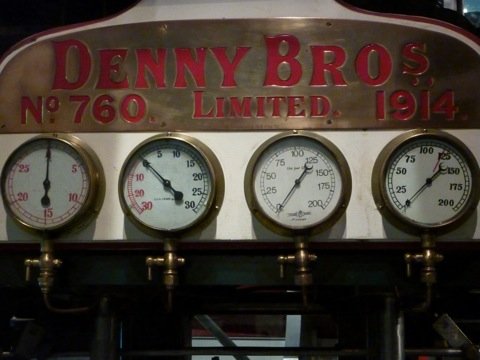
There are, of course, lots of other things at the museum too! These gauges are from a restored triple-expansion steam engine, formerly of the SS Perth, a ferry which plied the Swan River from 1914. Interestingly, it was owned and operated by the state government. Okay, well, I find that interesting.

SS Lady Forrest, a steam-powered pilot boat used at Fremantle from 1903 to 1967 (!). The Lady Forrest after whom it was named was the wife of Western Australia’s first premier, and the sister-in-law of the manager of Minderoo station, as previously discussed.
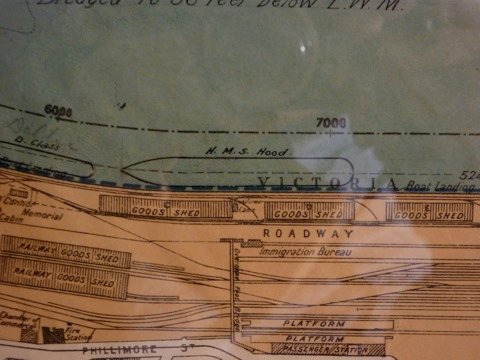
This is part of a reference map of Fremantle Harbour. That’s the mighty Hood, the world’s largest warship, tied up there at the docks (across the river mouth was HMS Repulse), which visited in 1924. As the biggest port for thousands of kilometres, Fremantle was an important link in the Empire’s defences.
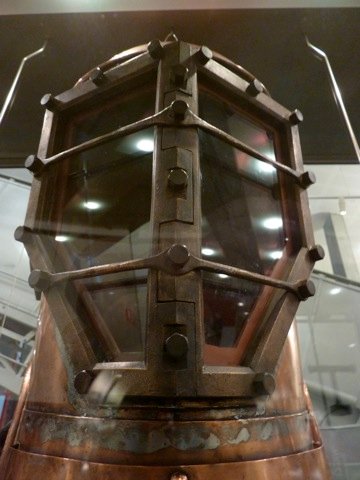
It became an important port for the Americans too, during the Second World War: over a hundred USN submarines were based here at one time. This is a wicked cool diving helmet they left behind, though it was probably used more in harbour clearance work than for fighting giant octopuses.
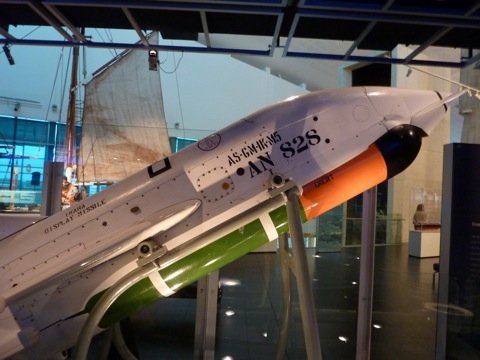
An Ikara anti-submarine missile, another Australian invention but a rather more lethal one than the winged keel. It was developed in the late 1950s to give naval vessels the ability to attack submarines at long ranges, up to 10 nautical miles. As can be seen above, rather than delivering a warhead itself, the Ikara carried an acoustic torpedo which it dropped into the water when near the target. Quite clever. It was fitted to the Royal Navy Leander-class frigates as well as Australian vessels.
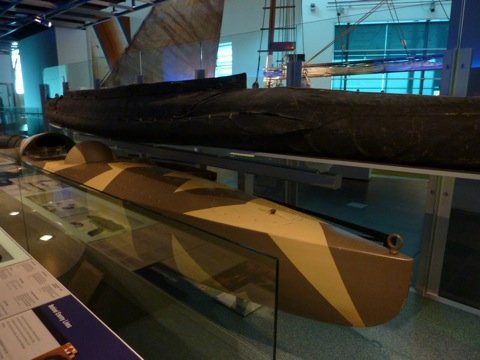
Above is a folding canoe and below is a submersible boat. Both are of the types used by Z Special Unit, a mostly-Australian unit which carried out clandestine missions behind Japanese lines in the Second World War. The most famous of these is Operation Jaywick, in which 14 British and Australian men in a fishing boat sailed from Australia to Singapore, where they attached limpet mines to Japanese merchant ships at harbour, sinking fourteen of them.

Nazi insignia from the uniform of a German seaman. The significance here is that the seaman was a crewmember of Kormoran, the raider which sank HMAS Sydney off the coast of Western Australia in November 1941. Kormoran had to be abandoned too, but that was small consolation for Australia.
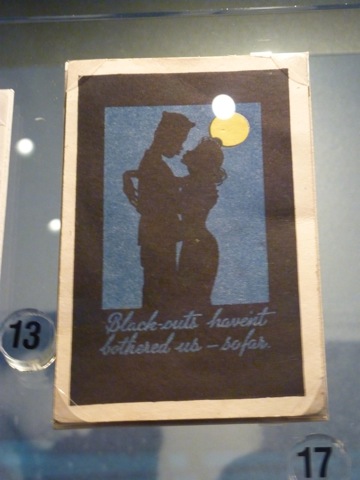
A slightly more cheerful end to the museum’s naval display — a postcard with a civil defence theme.

Another of the museum’s prize exhibits. Not as iconic as Australia II, but far more impressive (see the photo at the top of the post) — so big they had to put it outside. An Oberon-class submarine, formerly HMAS Ovens of the Royal Australian Navy, commissioned in 1969 and decommissioned in 1995.
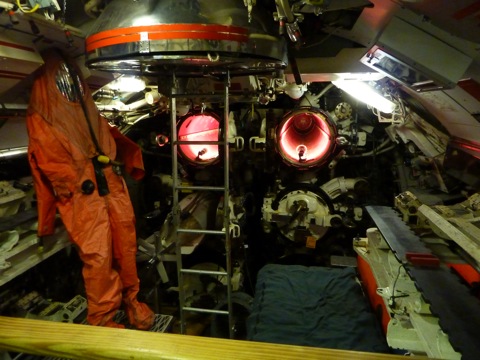
Of course, I signed up for the tour! The forward torpedo compartment, which doubled as an emergency escape chamber (note the orange emergency gear) and, er, tripled as temporary accommodation for special forces personnel.

The regular crewmen had far more palatial accommodation.

And, yes, I did say crewmen.
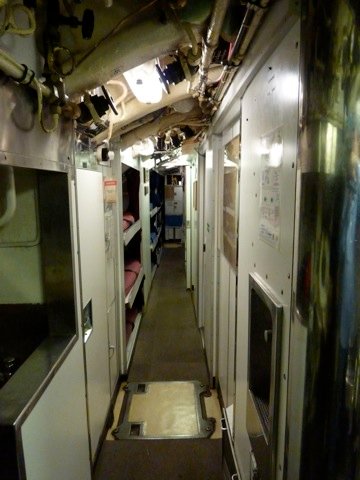
The standard complement was more than sixty; having walked from stern to prow it’s hard to see how they even managed to fit in all at once, let alone live together for weeks and months on end.

Despite being a Cold War sub, Ovens looks more Das Boot than Hunt for Red October. As a diesel-electric boat, it’s closer in many respects to Germany’s Type XXI U-boats than to the big nuclear-powered subs of the American and Soviet navies. On the other hand, its actual missions seem to have involved tracking Soviet subs transiting Australian waters, so it was doing the same job as its American hunter-killer counterparts, just more cost-effectively ($9 million! Even in 1969 dollars that’s nothing).
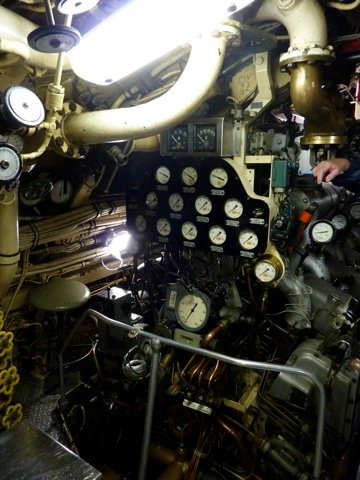
The Oberons had a reputation for being incredibly quiet. I imagine that wasn’t true in the engine room, however.
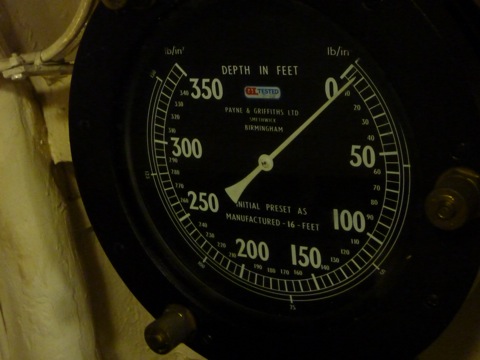
A depth gauge, an essential part of any submarine’s instrumentation. Note that this one was made in Birmingham. In fact, the whole submarine was made in Britain (the shipyard where it was launched was at Greenock). The six Oberons must have been about the last major combat systems Australia purchased from the British. (The RAAF has BAE Hawks but they’re primarily trainers.)
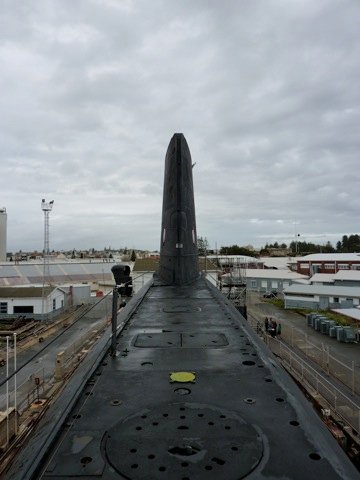
It’s a FIN, not a conning tower!

I wanted to know more about these dock cranes alongside the Ovens. They look like they might be from the war, but they haven’t been heritagised yet so there wasn’t any information about them.
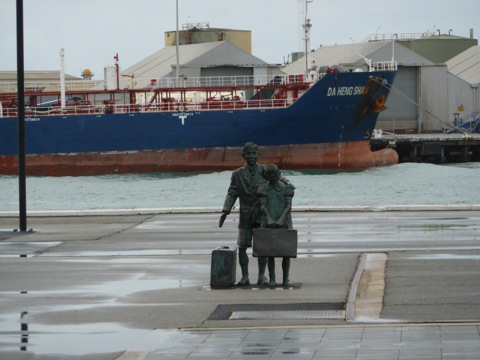
A reminder of one of Fremantle’s former roles. Many thousands of immigrants arrived here by sea, mostly from Europe, up until the 1960s. In fact, the port invested in a huge new building to welcome the influx to our shores, and help orient them to their new life in Australia, just in time for the advent of cheap air travel made it redundant. People arriving in Australia by boat these days are not nearly so welcome.
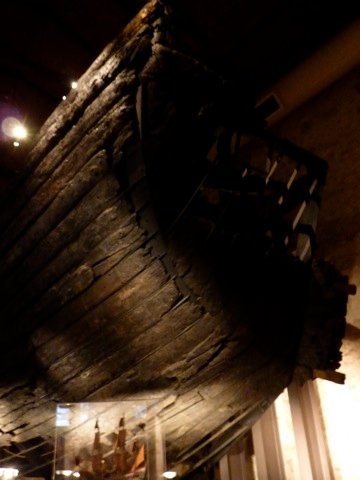
Now, the other maritime museum in Fremantle is the Western Australian Museum — Shipwreck Galleries. I only had about an hour to scamper through it, which was not long enough. Despite its humbler appearance, the Shipwreck Galleries hold a greater treasure than the Maritime Museum: the remains of the Batavia, a Dutch ship which was wrecked off the coast of Western Australia en route to the Dutch East Indies in 1628.

The tale of the Batavia is an amazing one, which I can scarcely do justice to here (mutiny! murder! mayhem!) But the end result, three centuries later, is that its stern has been raised from the seabed, carefully conserved, and put on display for the edification of gawpers like me.
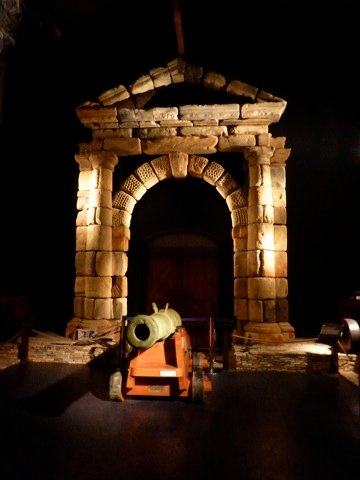
One of the Batavia‘s cannons, a bronze bowchaser. Unlike the other items on display, which were recovered by maritime archaeologists in the 1970s, this one was raised in 1963 by HMAS Diamantina, probably not in a very scholarly way!
Behind is a replica of a complete portico the Batavia was carrying to be erected at its destination (the original is in Geraldton).
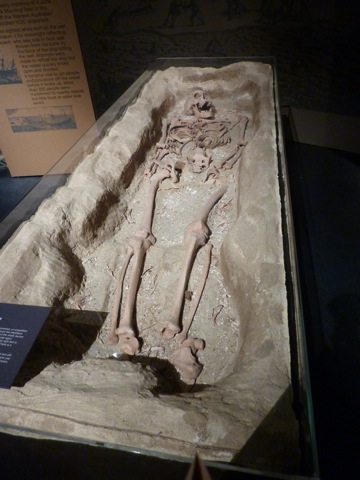
One of the victims of the Batavia mutiny, buried on Beacon Island. He seems to have met a violent end: his shoulder is broken and there is evidence of a knife or sword wound to his skull.
There was much more to see at the Shipwreck Galleries but I had no time for photos by this stage. From the large number of artefacts from East India Company wrecks, one might get the impression that the Dutch were just really bad sailors, but the British had their fair share too. In fact, only recently have I learned that my 5th great grandparents, John and Ann (Alford) Parsons and their childrend (including my 4th great grandmother, Harriet), were on board the Rockingham when it was driven aground by a gale, south of the Swan River colony (now Perth) on 14 May 1830. So recently it was after my visit to the Shipwreck Galleries — d’oh!

I didn’t get a chance to see much of the rest of Fremantle (which is a very pretty town from the bits I wandered through). In particular the Army Museum of Western Australia and the world-heritage listed Fremantle Prison will have to wait for another visit. But I did get to watch the sun set over the Indian Ocean.
![]() This work is licensed under a Creative Commons Attribution-NonCommercial-NoDerivatives 4.0 International License.
Permissions beyond the scope of this license may be available at http://airminded.org/copyright/.
This work is licensed under a Creative Commons Attribution-NonCommercial-NoDerivatives 4.0 International License.
Permissions beyond the scope of this license may be available at http://airminded.org/copyright/.


This is all terrific, thanks for sharing.
I also recall the fuss about the Australia II, they were still talking about it at the Australia pavilion at Expo ’86 in Vancouver, where I was living at the time. I’m embarrassed that I had no idea until now that the boat was from Perth — we western Canadians try to be sensitive to regional identity issues, as a matter of solidarity.
Well, that’s okay, it is called Australia II, not Western Australia II. So it’s understandable that you might assume it was from Sydney! :)
There was a shroud on it, right? Who knows what Australians keep under their shrouds down below….
I know, I know. I’m thinking like a submariner.